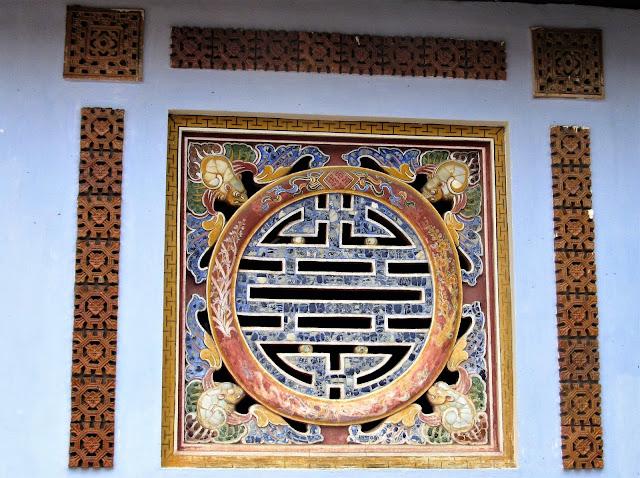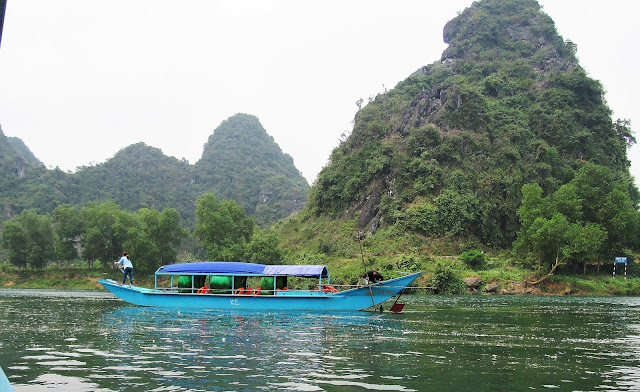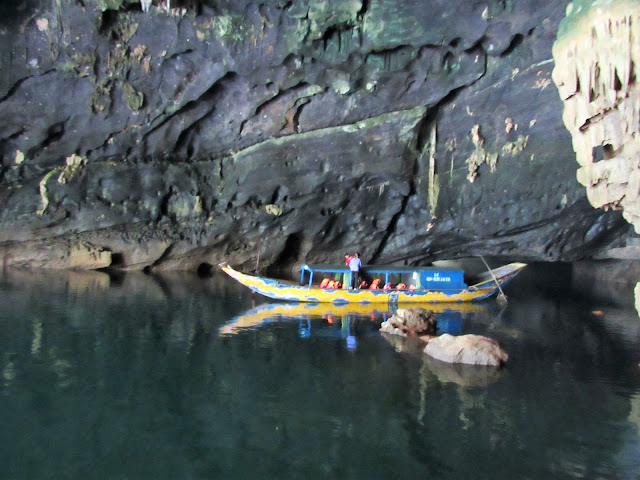Transparency: This post is being written in 2020 as we did not have a blog in 2016. I am using stay at home time to flatten the curve of the global pandemic Covid-19 to organize photos from this trip into a post. Memories may not be exact.
Hue
A UNESCO World Heritage Site, Hue was the capital city of Vietnam for 150 years from 1802 to 1945.
I can only find photos from a long day of walking around the Citadel/Imperial Palace. I don't know how long we stayed in Hue, nor much else of what we did here
The Citadel is surrounded by a moat ...
... and thick stone walls contain the Imperial City with palaces and shrines; the Forbidden Purple City reserved for the Emperor, his concubines and friends and a replica of the Royal Theatre. There are pagodas, temples, a library, museum and royal tombs. So much to see and learn.
The Citadel was constructed in 1804 and was the residence of Vietnam's royal dynasties for 143 years.
To get to the Citadel from our guesthouse we need to cross the Perfume River. We could do it in one of these water taxis, but opt to walk over the bridge.
Over the bridge and before the Citadel we pass through a pretty park
This is the most important part of the citadel ... the Hoan Tanh, or Royal Citadel. It's behind the exterior circle of the complex. There were rooms for grand ceremonies, shrines, offices, gardens and a place where princes could relax or study.
For security purposes, there are only one or two gates into this huge area. But within the complex to get to different areas there are gates to pass through. A few are in the photos below.
Many people take a horse and buggy ride or a golf cart type tour to get around but we walk and walk and...
Despite the size and grandeur we see, the complex is a mere shadow of what it once was. Only 20 of 160 buildings survived. Much damage was done during battles against the French in 1947 and again in 1968 by the Americans forces during the Tet Offensive.
Much restoration work is being done. This area has recently been restored and gleams with perfection:
One of the women doing the restoration work pauses to pose for us. Paul of course has done gold leaf work and we watch her work for a while.
This is the first time we have seen elaborate 3-D painted ceramic decoration on buildings. Below is a collage, then a couple of close-ups
I don't know what this building is for.
Where the Emperor could receive guests or for ceremonies
 |
| Emperor's Chair |
A sign informs us that several hundred men are involved in finding food: hunting big game, birds and fish. Local farmers grow special rice. Seafood and some exotic fruits are imported.
Numerous cooks prepare as many as fifty courses on the famous Hue Blue porcelain.
The Emperor usually dined alone and would choose only a few foods to eat.
Eunuchs had to transport the meals over considerable distances so the food was eaten at room temperature.
Security with food was a top priority. Food tasters took the first bite of everything the Emperor wanted to eat and he used special chopsticks that turned colour instantly if in contact with the poison. The chopsticks were used once and thrown out.
One building contains only works of art. We take our time through here. As we head towards the exit a man approaches Paul. He is an artist with works here and he did a sketch of Paul as we wandered about. He doesn't want money for it, he merely presents it as a gift.
There are many old photos to enjoy, especially of people and their 'dress' of the day. In the photo below I think the photo on the left may have been a young prince. In the middle, a eunuch. Whenever a child in the country was born with an indeterminate gender it was put in the care of a government ministry and eventually came to serve the imperial family. While treated with respect they were always at the beck and call of someone and often became depressed. The third photo is of a mandarin. There were many types of mandarins and many roles, both civil and military. They were the long arm of the rulers, represented imperial authority and had much respect.
Random Photos from the Citadel
We were pretty tired at the end of this day. You could visit here over two days.
When we leave our guesthouse one morning for a walk we notice a big shrine with lots of food on it that wasn't there before in front of the guest house. On return from the walk, the lobby has a huge table with mountains of food. All the staff, both those working and those on a day off are sitting there ready to dig in. This is a special day every year when employers appreciate their staff and put on a 'do' for them. We are invited to join them. Wow! What a feast and what a privilege.
Another day out walking, trying to find a small temple and standing in the street looking at a map, an elderly woman beckons us over to her yard. She speaks perfect English. We are invited into her home and she tells us her story. She was a young, educated, bilingual woman working as a librarian when the Vietnam war broke out. When the American army put out a call for translators she answered the call. They promised that if she worked for them for a certain amount of time that in addition to her regular salary, at the end of the war, the army would help her relocate to America and find a job there. The war ended a month or two before that specified amount of time and they offered her nothing. For years if she tried to speak with any tourists the police would harass her. She was seen somewhat as a traitor. She has kept up her English all these years by watching news broadcasts in English. This woman ran a small coffee service out of her kitchen in the morning for income. This income was supplemented by a nephew who was a surgeon in America. He sent money back every month to help five different relatives. Her share was $200/month. She obviously needed a hip replacement. Clearly, life is not easy here as people get older if they don't have a family. She lived alone with her cat but had a small, comfortable home. She was happy. We passed a whole afternoon with her and didn't miss going to the temple at all.
Phong Nha-Ke Bang National Park
The remote village of Phong Na is where most people stay to visit the Park although there were some farm stays quite a bit further out in Bong Lai Valley that we passed by bus where some people stayed. The town itself seems to be booming, lots of construction going on, likely as visitors to Vietnam are discovering the Park. It's a very picturesque countryside around the town.
 |
| Cemetary |
I don't know what happens with school here, but the two boys above clearly weren't in school this day. They latched onto us for about an hour and were just clowning around. Cute!
The Phong Na-Ke Bang cave system is a UNESCO World Heritage Site. Because a major part of the Ho Chi Minh Trail went through here, the area was bombed repeatedly during the Vietnam War.
The cave system is the largest in the world covering 126,754 hectares and to the west borders with a Nature Reserve in Laos. This limestone karst ecosystem has 104 kilometres of caves (about 500 caves) and underground rivers.
Dong Thien Duong Cave
AKA: Paradise Cave, or the Underground Palace
This cave was discovered in 2005 by a local man accompanied by the British Cave Research Association. The entire 31 km of the cave has now been explored but only 900 meters is open to the public. The cave is up to 100 meters in height and 150 meters wide It's said to be the most beautiful cave in the system.
 |
| Going down into the cave |
This is certainly one of the biggest and most beautiful caves we've been in.
Another day we walk to the river bank and get a boat that will take us into a cave with a river.
Scenes along the river to get to the cave:
Cave Entrance
We boat into the end then walk back along a ledge in the cave.
The so blue water as we near the entrance on the way out
One day we rent a scooter in town and head out, stopping as we see a sign for an orchid walk. The walk was pretty enough but it wasn't really the orchid blooming season.
Leaving here, the road winds up a mountain, which is where the scooter dies. Paul rolls it down the mountain hoping it will start, me running behind until we realize it won't start, then I climb on and we coast back down to the orchid walk. At least we can borrow a phone there to call someone if we need to, but with some fiddling around Paul gets it started and we return to town not trusting it to take us anywhere. The rental place wanted to charge us a full day of rent for our couple of hour's experience. Some haggling and we walk away satisfied.
Glad we came to the park. Now we're off to Hanoi.
Water Puppet Theatre
On the road between Hanoi and Ha Long Bay, we pause to watch a water puppet show. The show consists of many short plays that tell stories of local life such as fishing and farming as well as keeping local legends alive. There is live musical accompaniment on the land and they are great little stories.
The art of making puppets dance on water has been around in Vietnam since the 11th. century (much longer in China). Puppets can be 50 cm or more in height with the puppeteers standing in waist-deep water, manipulating the puppets with bamboo poles and/or track mechanisms.
 |
| Musicians |
From a variety of skits of legend and duck farming
 |
| In the end, the farm raider gets to eat |
 |
| Final acknowledgement to the audience by the Puppeteers |
We arrive in Hanoi on a night bus two hours ahead of schedule about 6 am in the pouring rain, in the dark, in a gravel pit. A taxi driver drops us off at a narrow alley and points down it. We don't know what to think, but off we go. There is no street access to our guest house.
Paul is really sick now with dengue. Our host takes one look at him then tells us to go to the hostel next door for a coffee while he gets a room ready for us for a very early check-in which he does not charge us for. He also gives us free breakfast that day.
Paul is in bed for a couple of days with a high fever. I go to several drug stores to try to find a thermometer but am met with blank stares when I show them what I want on Google Translate.
Finally, his fever breaks just before we head off to Ha Long Bay. We'll be back to Hanoi again after the boat trip for a bit of sight-seeing.
Ha Long & Bai Tu Long Bay
We decide to really treat ourselves and do an overnight Dragon Boat trip. Today we consider ourselves lucky as the boat took us from Ha Long Bay up to Bai Tu Long Bay where we over-nighted on the boat then returned the next day. The following year, in 2017 the government decreed that all of the boats had to stay in Ha Long Bay. Ha Long is so crowded with boats now that it won't be nearly as nice of a trip. Indeed a couple of years later we see a post from a friend who did the trip but Bai Tu Long Bay was not included.
These two bays are featured on just about every tourist photo ad that exists for Vietnam because the scenery is like nothing we are used to. There are literally thousands of limestone karsts and islets rising out of the misty water.
The name Ha Long means descending dragons and refers to the ancient legend where dragons were sent to help the Vietnamese people defend against invaders.
I think we have the prettiest ship on the water. We don't have a photo of the entire boat, only bits of it:
 |
| Bow |
 |
| Stern |
 |
| We're underway |
The top deck has loungers and a pool.
The scenery along the way:
 |
| Looking Behind as We Head Out of Port |
A couple of times we can launch a kayak off the back of the ship. It's so peaceful in the calm Bai Tu Long Bay to glide amongst the majestic karst islets and the dragon boats. I go once with a crew and once by myself. We were instructed that if we found any garbage floating in the water that we were to put it on/in our kayak and bring it back to the ship. There was very little garbage. Paul gets up to something else.
We can also get off the boat to lounge and swim on a beach and to go to a cave. We do it all.
The food on the ship was first class. When I was handed the menu I thought we were to pick an item from it to eat. No. There were about 8 items on the menu. All the different courses. So dinner was a long, lingering event under the stars with a bottle of wine.
Here, for example, was an appy:
On the table were incredible vegetable sculptures created by the chefs. After dinner, they took a bow with their work of art.
A collage of different views of a dragon:
A collage of different views of a sea eagle:
The rocking of the waves brings a peaceful sleep.
There's a dawn Thai Chi class on the upper deck in the morning that I head up for.
It's a beautiful trip back and its hard to leave all this beauty and comfort.
We're back to Hanoi for a couple of days of sightseeing then a flight to Luang Probang, Laos.



















































































No comments:
Post a Comment